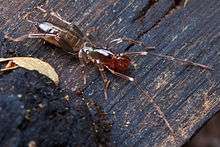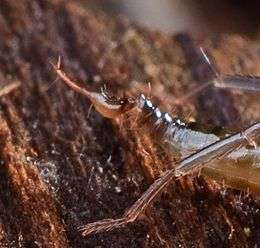Schizomida
Schizomida (common name shorttailed whipscorpion)[1] is an order of arachnids, generally less than 5 millimetres (0.20 in) in length.
| Schizomida | |
|---|---|
 | |
| Female Hubbardia pentapeltis | |
| Scientific classification | |
| Kingdom: | Animalia |
| Phylum: | Arthropoda |
| Subphylum: | Chelicerata |
| Class: | Arachnida |
| Order: | Schizomida Petrunkevitch, 1945 |
| Families | |
|
† Calcitronidae Petrunkevitch, 1945b | |
The order is not yet widely studied. As of 2005, more than 230 species of schizomids have been described worldwide, most belonging to the Hubbardiidae family. A systematic review including a full catalogue may be found in Reddell & Cokendolpher (1995). The Schizomida is sister to the order Uropygi, the two clades together forming the Thelyphonida.[2] Based on molecular clock dates, both orders likely originated in the late Carboniferous somewhere in the tropics of Pangea, and the Schizomida underwent substantial diversification starting in the Cretaceous.[2] The oldest known fossil is currently Mesozomus from the Mid-Cretaceous Burmese amber of Myanmar.[3]
E. O. Wilson has identified schizomids as among the "groups of organisms that desperately need experts to work on them."[4]
Anatomy
Schizomids are relatively big, soft-bodied arachnids, somewhat similar in appearance to whip scorpions. The prosoma (cephalothorax) is divided into three regions, each covered by plates, the large protopeltidium and the smaller, paired, mesopeltidia and metapeltidia. The name means "split or cleaved middle", referring to the way the prosoma is divided into two separate plates.[5]

The opisthosoma (abdomen) is a smooth oval of 12 recognizable segments. The first is reduced and forms the pedicel, while the last three are constricted, forming the pygidium. The last segment bears a short whip-like tail or flagellum, consisting of no more than four segments. The females generally have 3-4-segmented flagella, while in males it is single segmented.[6]
Like the related orders Thelyphonida and Amblypygi, and the more distantly related Solifugae, the schizomids use only six legs for walking, having modified their first two legs to serve as sensory organs. They also have large well-developed pincer-like pedipalps just before the sensory legs. The hind legs are modified for jumping, as part of their escape response when threatened.[7] Schizomids have no actual eyes, but a few species have vestigial eyespots capable of telling light from dark. They breathe through a single pair of book lungs, as the other pair is lost.[8]
Habitat
Schizomids are generally tropical creatures, although some populations have been found in California and Arizona. They tend to live in the top layer of soil and in the cavities beneath logs and rocks, where they can avoid desiccation. They seek water and avoid light. Some species are cave dwellers, and a few live in or near termite or ant colonies.
Subtaxa
Schizomids are grouped into three families:
- Calcitronidae † (fossil) (dubious)
- Hubbardiidae
- Protoschizomidae (2 genera, 15 species)
- Agastoschizomus
- Protoschizomus
References
- The American Arachnological Society Committee on Common Names of Arachnids (2003). R.G. Breene (chair) (ed.). Common Names of Arachnids 2003 (PDF) (5th ed.). Carlsbad, NM: American Tarantula Society. p. 42. ISBN 1-929427-11-5. Archived from the original (PDF online publication) on 2006-09-27.
- Clouse, Ronald M.; Branstetter, Michael G.; Buenavente, Perry; Crowley, Louise M.; Czekanski‐Moir, Jesse; General, David Emmanuel M.; Giribet, Gonzalo; Harvey, Mark S.; Janies, Daniel A. (2017). "First global molecular phylogeny and biogeographical analysis of two arachnid orders (Schizomida and Uropygi) supports a tropical Pangean origin and mid-Cretaceous diversification". Journal of Biogeography. 44 (11): 2660–2672. doi:10.1111/jbi.13076. ISSN 1365-2699.
- Sandro P. Müller; Jason A. Dunlop; Ulrich Kotthoff; Jörg U. Hammel; Danilo Harms (2019). "The oldest short-tailed whipscorpion (Schizomida): a new genus and species from the Upper Cretaceous amber of northern Myanmar". Cretaceous Research. in press: Article 104227. doi:10.1016/j.cretres.2019.104227.
- Tyson, Charlie (May 7, 2019). "A Legendary Scientist Sounds Off on the Trouble With STEM". The Chronicle of Higher Education. Retrieved 2020-06-12.
- Barnes, Robert D. (1982). Invertebrate Zoology. Philadelphia, PA: Holt-Saunders International. pp. 615–617. ISBN 0-03-056747-5.
- Coddington J.A. et al. "Arachnida", p. 306, in: J. Cracraft (ed.) Assembling the Tree of Life, pp. 296-318
- Humphreys, W.F., et al. (1989) The biology of Schizomus vinei (Chelicerata: Schizomida) in the caves of Cape Range, Western Australia. J. ZOol. Lond. 217: 177-201.
- Geological history and phylogeny of Chelicerata
- Reddell, J.R. & Cokendolpher, J.C. (1995). Catalogue, bibliography, and generic revision of the order Schizomida (Arachnida). Tex. Mem. Mus., Speleol. Monogr. 4: 1-170
- Savory, T., 1977. Arachnida. second edition. Academic Press inc. New York. 339pp.
| Wikimedia Commons has media related to Schizomida. |